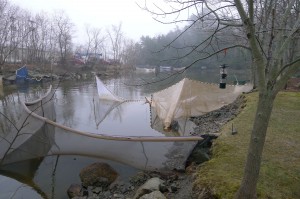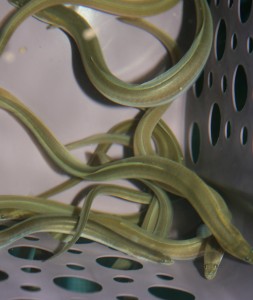American eels
Anguilla rostrata

Every spring juvenile eels, known as glass eels or elvers, complete a long and mysterious migration from spawning grounds in the Sargasso Sea to coastal waters, freshwater streams and rivers up and down the North American Atlantic coast. There they may spend from 5 to 20 years feeding and growing to maturity, before the adults once again swim to the Sargasso Sea to spawn. The return migration of baby eels has long supported a fishery in Maine to supply aquaculture farms in Asia. The dock price for a pound of live freshly caught elvers has exceeded $2,000 per pound in recent years, making it the most lucrative fishery product in Maine. The elvers are shipped to Asia, where they are grown in ponds or tanks for 1-2 years to market, then harvested as a delicacy (in Japan it is known as unagi, a delicious dish of smoked eel and teriyaki sauce on a bed of rice).
Over the years, people in Maine and Canada have tried to farm American eels locally rather than shipping them to Asia, but previous attempts proved uneconomical. However, as consumer demand for eels grows, the price of wild elvers rises, placing increased pressure on wild stocks. Other regions around the world outside of Asia now see new opportunity in eel farming. This is certainly the case in Maine, which has a long aquaculture tradition and ready access to native stocks of American eels. In recent years, the Center for Cooperative Aquaculture Research has fielded several inquiries into eel farming, and in 2016 we began working with our first start-up company to grow eels. Stay tuned to this page for further developments as they happen!
Challenges of eel aquaculture include:
- Hatchery cycle It’s proven extremely difficult to rear baby eels, known as leptocephali, in captivity. This is why all eel aquaculture today is capture based, that is, wild eels are captured and then grown in captivity. In recent years Japanese researchers have succeeded in rearing very small numbers of leptocephalus larvae in captivity, but we may still be years away from being able to rear enough hatchery numbers to supply aquaculture farms. As the hatchery technology for eels improves, we hope to add American eels to the list of CCAR hatchery species.
- eels are sexually indeterminate Environmental factors play an important role in determining whether an immature eel develops as male or female. Intensive farming conditions can influence immature eels to develop into males, resulting in a mostly male crop. Although males may initially grow faster, females overtake them to reach market size sooner. Husbandry methods (for example, lower stocking densities) and hormonal control targeted at early development can produce a more desirable female crop.
- eels are escape artists eels can climb tank walls or slither through drain openings, especially when they are small, so aquaculture tanks and drains need special modifications to prevent the eels from escaping.

